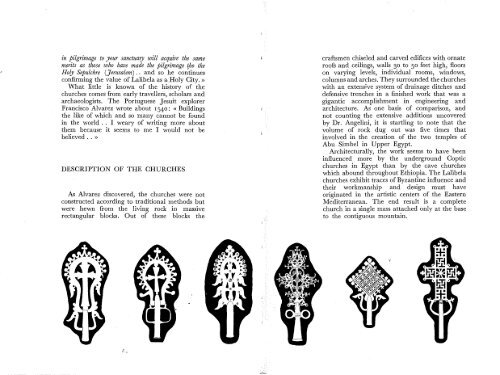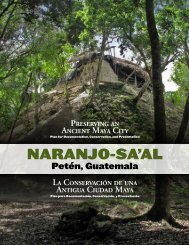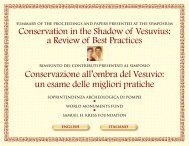Lalibela, Phase I (pdf) - World Monuments Fund
Lalibela, Phase I (pdf) - World Monuments Fund
Lalibela, Phase I (pdf) - World Monuments Fund
Create successful ePaper yourself
Turn your PDF publications into a flip-book with our unique Google optimized e-Paper software.
in pilgrimage to your sanctuary will acquire the same<br />
merits as those who have made the pilgrimage iho the<br />
HolY Sepulchre (Jerusalem) .. and so he continues<br />
confirming the value of Lalibe1a as aHoly City. »<br />
What little is known of the history of the<br />
churches comes from early travellers, scholars and<br />
archaeologists. The Portuguese Jesuit explorer<br />
Francisco Alvarez wrote about 1540: «Buildings<br />
the like of which and so many cannot be found<br />
in the world .. I weary of writing. more about<br />
them because it seems to me I would not be<br />
believed .. »<br />
DESCRIPTION OF THE CHURCHES<br />
As Alvarez discovered, the churches were not<br />
constructed according to traditional methods but<br />
were hewn from the living rock in massive<br />
rectangular blocks. Out of these blocks the<br />
craftsmen chiseled and carved edifices with ornate<br />
roofs and ceilings, walls 30 to 50 feet high, floors<br />
on varying levels, individual rooms, windows,<br />
columns and arches. They surrounded the churches<br />
with an extensive system of drainage ditches and<br />
defensive trenches in a finished work that was a<br />
gigantic accomplishment in engineering and<br />
architecture. As one basis of comparison, and<br />
not counting the extensive additions uncovered<br />
by Dr. Angelini, it is startling to note that the<br />
volume of rock dug out was five times that<br />
involved in the creation of the two temples of<br />
Abu Simbel in Upper Egypt.<br />
Architecturally, the work seems to have been<br />
influenced more by the underground Coptic<br />
churches in Egypt than by the cave churches<br />
which abound throughout Ethiopia. The <strong>Lalibela</strong><br />
churches exhibit traces ofByzantine influence and<br />
their workmanship and design must have<br />
originated in the artistic centers of the Eastern<br />
Mediterranean. The end result is a complete<br />
church in a single mass attached only at the base<br />
to the contiguous mountain.
















